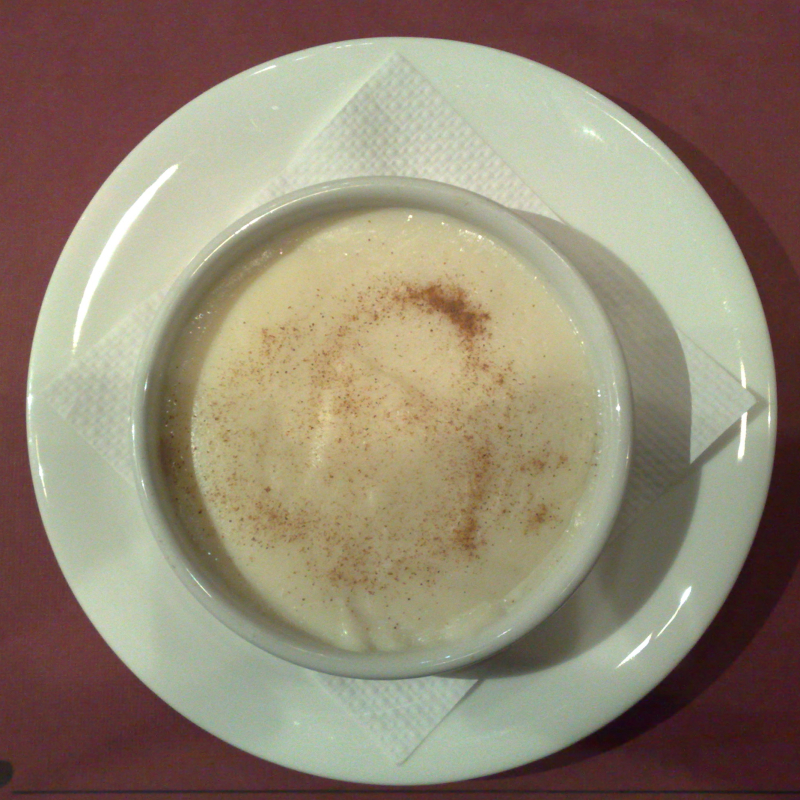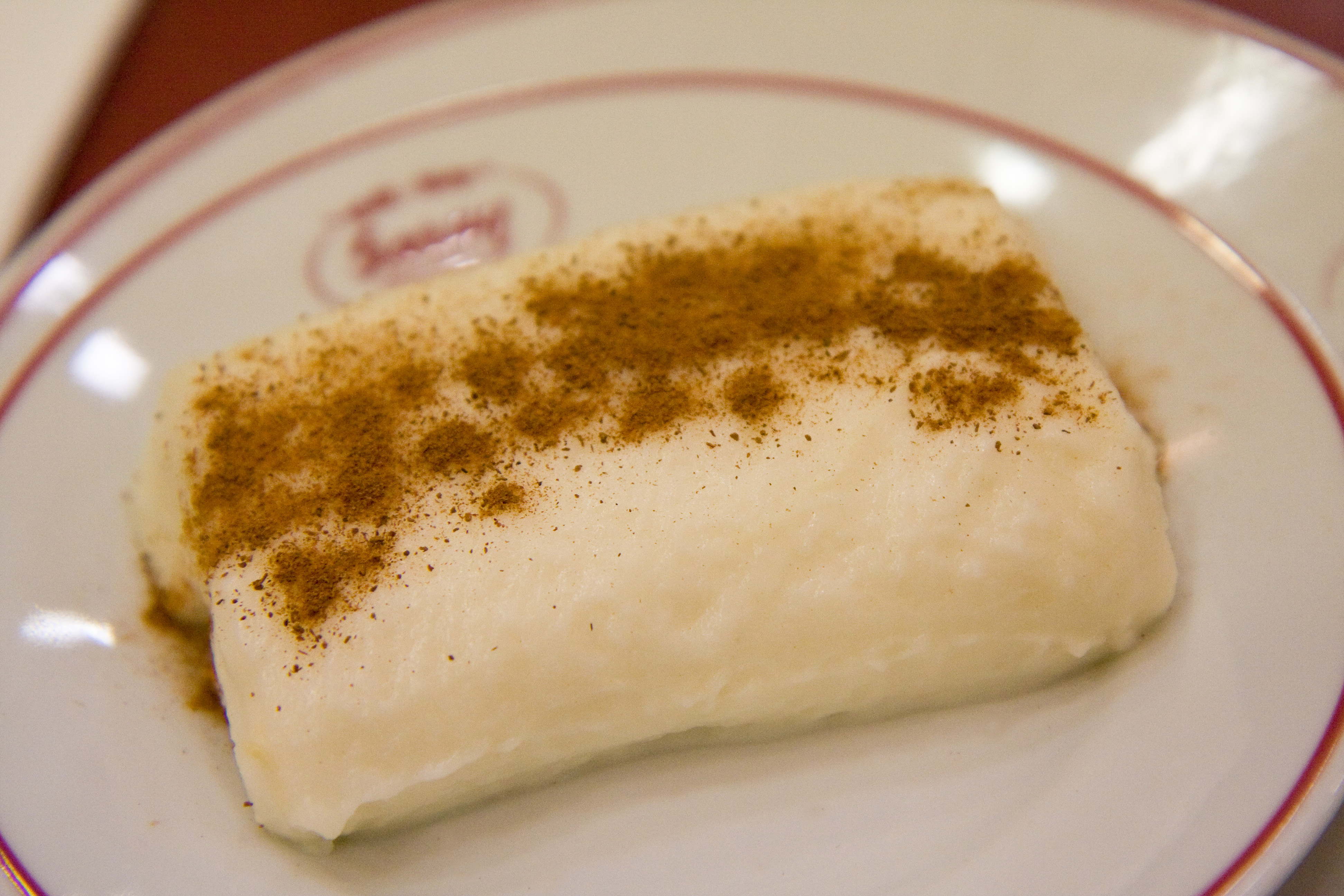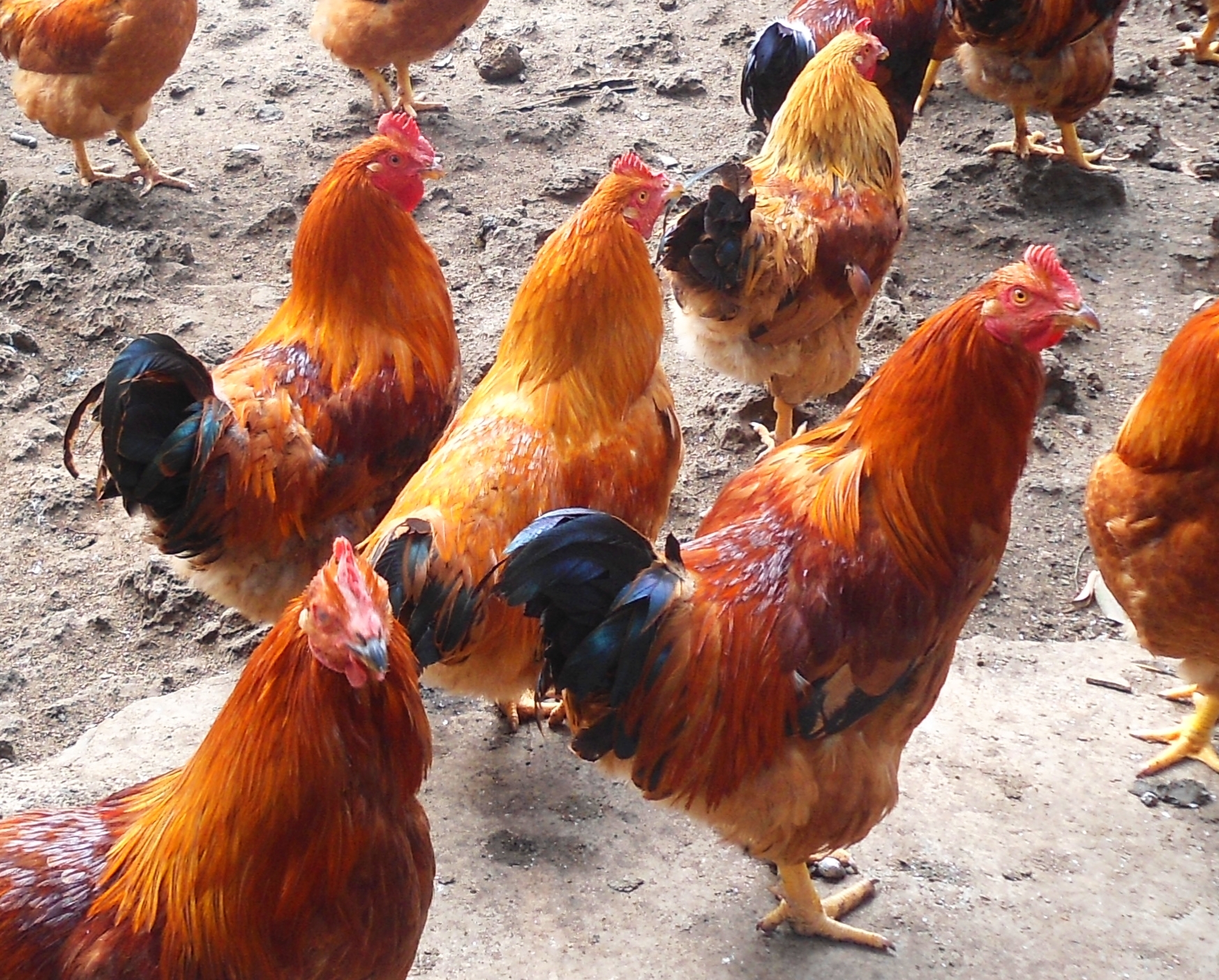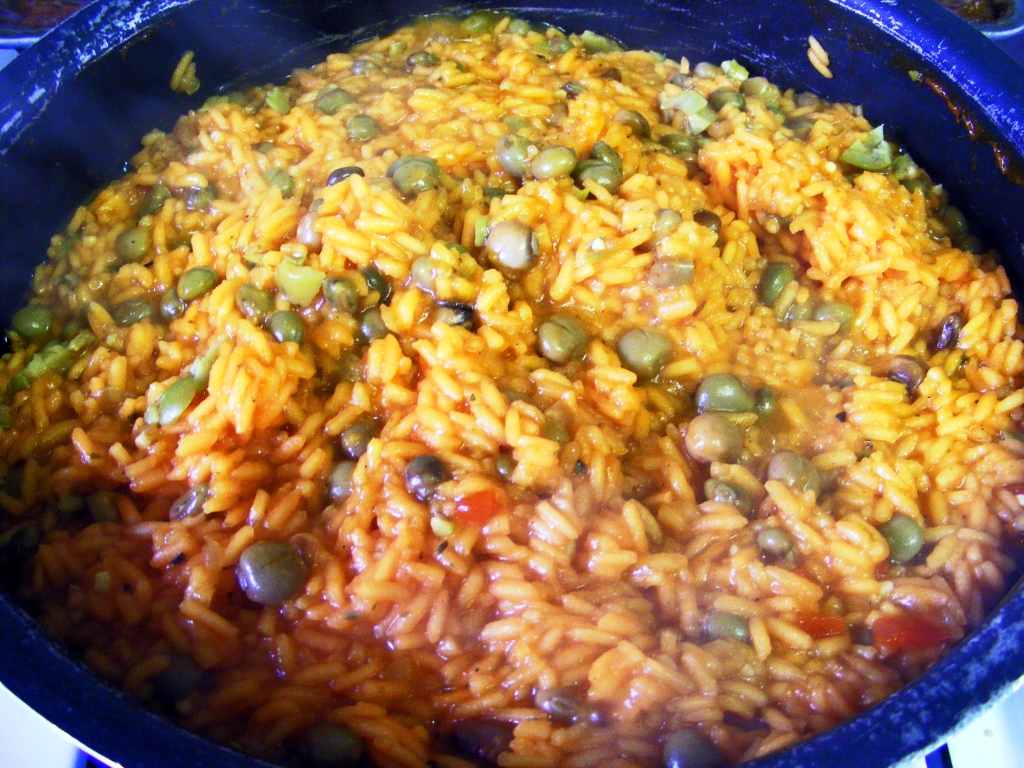|
Blanc Mange
Blancmange (, from french: blanc-manger ) is a sweet dessert popular throughout Europe commonly made with milk or cream and sugar thickened with rice flour, gelatin, corn starch, or Irish moss (a source of carrageenan), and often flavoured with almonds. It is usually set in a mould and served cold. Although traditionally white (hence the name, in English literally "white eating"), blancmanges are frequently given alternative colours. Some similar desserts are French chef 's Bavarian cream, Italian , the Middle Eastern , Chinese ''annin tofu,'' Hawai'ian and Puerto Rican . The historical blancmange originated at some time during the Middle Ages and usually consisted of capon or chicken, milk or almond milk, rice, and sugar and was considered to be ideal for the sick. is a sweet contemporary Turkish pudding made with shredded chicken, similar to the medieval European dish. History The origins of the blancmange have long been believed to lie in the introduction of rice and ... [...More Info...] [...Related Items...] OR: [Wikipedia] [Google] [Baidu] |
Dessert
Dessert is a course (food), course that concludes a meal. The course consists of sweet foods, such as confections, and possibly a beverage such as dessert wine and liqueur. In some parts of the world, such as much of Greece and West Africa, and most parts of China, there is no tradition of a dessert course to conclude a meal. The term ''dessert'' can apply to many confectionery, confections, such as biscuits, cakes, cookies, custards, gelatin dessert, gelatins, ice creams, pastry, pastries, pies, puddings, macaroons, tong sui, sweet soups, tarts, and fruit salad. Fruit is also commonly found in dessert courses because of its naturally occurring sweetness. Some cultures sweeten foods that are more commonly umami, savory to create desserts. Etymology The word "dessert" originated from the French word ''desservir,'' meaning "to clear the table". Its first known use in English was in 1600, in a health education manual entitled ''Naturall and artificial Directions for Health'', w ... [...More Info...] [...Related Items...] OR: [Wikipedia] [Google] [Baidu] |
Panna Cotta
Panna cotta (Italian for "cooked cream") is an Italian dessert of sweetened cream thickened with gelatin and molded. The cream may be aromatized with coffee, vanilla, or other flavorings. History The name ''panna cotta'' is not mentioned in Italian cookbooks before the 1960s,Luigi Carnacina, Luigi Veronelli, "Panna Cotta," ''La Cucina Rustica Regionale'' 1:156, 1977, based on ''La Buona Vera Cucina Italiana'' (not seen), 1966Camilla V. Saulsbury, ''Panna Cotta: Italy's Elegant Custard Made Easy'', p. 14 yet it is often cited as a traditional dessert of the northern Italian region of Piedmont. One unverified story says that it was invented by a Hungarian woman in the Langhe in the early 1900s. An 1879 dictionary mentions a dish called ''latte inglese'' 'English milk,' made of cream cooked with gelatin and molded, though other sources say that ''latte inglese'' is made with egg yolks, like crème anglaise; perhaps the name covered any thickened custard-like preparation. It could a ... [...More Info...] [...Related Items...] OR: [Wikipedia] [Google] [Baidu] |
Tavuk Göğsü
Tavuk göğsü ( tr, tavukgöğsü, , "chicken breast") is a Turkish dessert, Turkish muhallebi, milk pudding made with chicken meat, shredded chicken breast. It was a delicacy served to Ottoman sultans in the Topkapı Palace, and is now a well-known dish in Turkey. It has long been believed that this chicken pudding had originated in the Roman recipe collection Apicius, and it was later on passed to Eastern Roman Empire (Byzantium) and subsequently to the Ottoman Empire. However, no surviving copies of Apicius include such a recipe. Similar Arab dishes from the tenth century exist. Considering the lack of evidence for the Roman connection, the possible introduction of tavuk göğsü into Turkish cuisine is likely of Arab origin. The traditional version uses white chicken breast meat. The meat is softened by boiling and separating the meat into very fine fibers or pounding until smooth. The meat is mixed with milk, sugar, cracked rice and other thickeners, and often some sort of f ... [...More Info...] [...Related Items...] OR: [Wikipedia] [Google] [Baidu] |
Almond Milk
Almond milk is a plant-based milk with a watery texture and nutty flavor manufactured from almonds, although some types or brands are flavored in imitation of cow's milk. It does not contain cholesterol or lactose and is low in saturated fat. Almond milk is often consumed by those who are lactose-intolerant and others, such as vegans, who avoid dairy products. Commercial almond milk comes in sweetened, unsweetened, vanilla and chocolate flavors, and is usually fortified with micronutrients. It can also be made at home using a blender, almonds and water. Global almond milk sales in 2018 were US$5.8 billion, growing at 14% per year, and forecast to be a $13 billion global market by 2025. History Almond milk was used as a substitute for animal milk in the Middle Ages in areas that followed Catholic fasting doctrines. Historian Carolyn Walker Bynum notes that: medieval cookbooks suggest that the aristocracy observed fasting strictly, if legalistically. Meat-day and ... [...More Info...] [...Related Items...] OR: [Wikipedia] [Google] [Baidu] |
Chicken As Food
Chicken is the most common type of poultry in the world. Owing to the relative ease and low cost of raising chickens—in comparison to mammals such as cattle or hogs—chicken meat (commonly called just "chicken") and chicken eggs have become prevalent in numerous cuisines. Chicken can be prepared in a vast range of ways, including baking, grilling, barbecuing, frying, and boiling. Since the latter half of the 20th century, prepared chicken has become a staple of fast food. Chicken is sometimes cited as being more healthful than red meat, with lower concentrations of cholesterol and saturated fat. The poultry farming industry that accounts for chicken production takes on a range of forms across different parts of the world. In developed countries, chickens are typically subject to intensive farming methods while less-developed areas raise chickens using more traditional farming techniques. The United Nations estimates there to be 19 billion chickens on Earth today, m ... [...More Info...] [...Related Items...] OR: [Wikipedia] [Google] [Baidu] |
Capon
A capon (from la, cāpō, genitive ''cāpōnis'') is a cockerel (rooster) that has been castrated or neutered, either physically or chemically, to improve the quality of its flesh for food, and, in some countries like Spain, fattened by forced feeding. History The origins of caponised chickens are contested. They were known in ancient China as well as in ancient Greece and ancient Rome. An early record of caponisation is found under the Roman Republic: the Lex Faunia of 162 BC forbade fattening hens to conserve grain rations, so the Romans instead castrated roosters, which resulted in a doubling of size. It was also practiced later throughout medieval times, with gastronomic texts describing capons as preferred poultry since the ordinary fowl of the farmyard was regarded as peasant fare and "popular malice crediting monks with a weakness for capons." France is internationally renowned for maintaining a strong caponisation tradition with widespread and established industr ... [...More Info...] [...Related Items...] OR: [Wikipedia] [Google] [Baidu] |
Middle Ages
In the history of Europe, the Middle Ages or medieval period lasted approximately from the late 5th to the late 15th centuries, similar to the post-classical period of global history. It began with the fall of the Western Roman Empire and transitioned into the Renaissance and the Age of Discovery. The Middle Ages is the middle period of the three traditional divisions of Western history: classical antiquity, the medieval period, and the modern period. The medieval period is itself subdivided into the Early, High, and Late Middle Ages. Population decline, counterurbanisation, the collapse of centralized authority, invasions, and mass migrations of tribes, which had begun in late antiquity, continued into the Early Middle Ages. The large-scale movements of the Migration Period, including various Germanic peoples, formed new kingdoms in what remained of the Western Roman Empire. In the 7th century, North Africa and the Middle East—most recently part of the Eastern Ro ... [...More Info...] [...Related Items...] OR: [Wikipedia] [Google] [Baidu] |
Tembleque
Tembleque is a coconut dessert pudding from Puerto Rico. It is one of the most popular desserts in Puerto Rican cuisine. Ingredients is made by cooking coconut cream, coconut milk, heavy cream (optional), salt, cornstarch, sugar, frequently orange blossom water, and garnished with ground cinnamon. Tembleque can also be topped with a relish or syrup usually made with sugar, liqueur, spices, fruit juice or diced, and wine or simply chocolate shavings on top. Cultural importance It is a holiday dish, served on New Year's Day throughout the island of Puerto Rico. While the recipe may have originated in Puerto Rico, there are variants on the dish in Latin America and other countries. In Brazil, the dish is known as manjar branco. According to the Encyclopedia of Puerto Rico, published by the Foundation for the Humanities, each time a Puerto Rican migrant to the United States comes closer and closer to forgetting their roots, foods like bring them back and remind them of who t ... [...More Info...] [...Related Items...] OR: [Wikipedia] [Google] [Baidu] |
Puerto Rican Cuisine
Puerto Rican cuisine has its roots in the cooking traditions and practices of Europe (mostly Spain), Africa and the native Taínos. History Puerto Rican cuisine has been influenced by an array of cultures including Taino Arawak, Spanish, and African. Although Puerto Rican cooking is somewhat similar to both Spanish and other Latin American cuisine, it reflects a unique blend of influences, using indigenous seasonings and ingredients. Locals call their cuisine ''cocina criolla''. By the end of the nineteenth century, the traditional Puerto Rican cuisine was well established. By 1848 the first restaurant, La Mallorquina, opened in Old San Juan. ''El Cocinero Puerto-Riqueño o Formulario'', the island's first cookbook, was published in 1849. Taíno influence ''See: Native American cuisine'' From the diet of the Taíno (culturally related with the Maya and Carib peoples of Central America and the Caribbean) and Arawak people come many tropical roots and tubers (collectively ... [...More Info...] [...Related Items...] OR: [Wikipedia] [Google] [Baidu] |
Haupia
Haupia is a Cuisine of Hawaii, traditional coconut milk-based Native Hawaiians, Hawaiian dessert often found at luaus and other local gatherings in Hawaii. Since the 1940s, it has become popular as a topping for white cake, especially at weddings. Although technically considered a pudding, the consistency of haupia closely approximates gelatin dessert, and it is usually served in blocks like gelatin. It is also served in local ice cream parlors as Haupia Ice Cream. History The traditional Hawaiian recipe for haupia calls for heated coconut milk to be mixed with ground ''pia'' (Polynesian arrowroot, ''Tacca leontopetaloides'') until the mixture thickens. Due to the lack of availability of arrowroot starch, some modern recipes for haupia substitute cornstarch. Haupia is very similar to the European dessert Blancmange (food), blancmange. In the typical modern recipe, diluted coconut milk, sugar, and salt are mixed with arrowroot or cornstarch and heated until thickened and smooth, ... [...More Info...] [...Related Items...] OR: [Wikipedia] [Google] [Baidu] |
Hawaiʻi
Hawaii ( ; haw, Hawaii or ) is a state in the Western United States, located in the Pacific Ocean about from the U.S. mainland. It is the only U.S. state outside North America, the only state that is an archipelago, and the only state geographically located within the tropics. Hawaii comprises nearly the entire Hawaiian archipelago, 137 volcanic islands spanning that are physiographically and ethnologically part of the Polynesian subregion of Oceania. The state's ocean coastline is consequently the fourth-longest in the U.S., at about . The eight main islands, from northwest to southeast, are Niihau, Kauai, Oahu, Molokai, Lānai, Kahoolawe, Maui, and Hawaii—the last of these, after which the state is named, is often called the "Big Island" or "Hawaii Island" to avoid confusion with the state or archipelago. The uninhabited Northwestern Hawaiian Islands make up most of the Papahānaumokuākea Marine National Monument, the United States' largest protected are ... [...More Info...] [...Related Items...] OR: [Wikipedia] [Google] [Baidu] |
Annin Tofu
Annin tofu or xingren tofu (), sometimes translated as almond tofu, is a soft, jellied dessert made of apricot kernel milk, agar, and sugar. It is a traditional dessert of Chinese cuisine, and Japanese cuisine. A similar dessert is blancmange. The name "tofu" here refers to "tofu-like solid"; soy beans, which are the main ingredient of tofu, are not used. This naming convention is also seen in other East Asian dishes, such as Chinese () and Japanese . Apricot kernel milk is often confused with almond milk, as apricot kernel itself is often confused with almond. Traditional recipe In the traditional recipe, the primary flavoring agent is apricot kernels, soaked and ground with water. The mixture is strained, sweetened, and heated with a gelling agent (usually agar). When chilled, the apricot kernel milk mixture solidifies into the consistency of a soft gelatin dessert. Variations Although the agar-based recipe is vegan, there are numerous nontraditional recipes that are not. ... [...More Info...] [...Related Items...] OR: [Wikipedia] [Google] [Baidu] |








